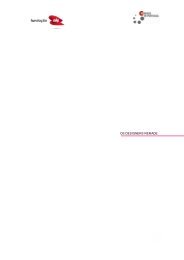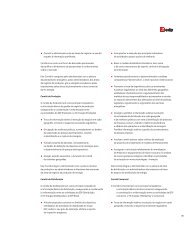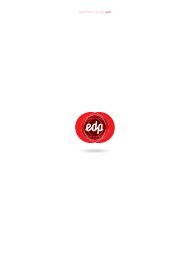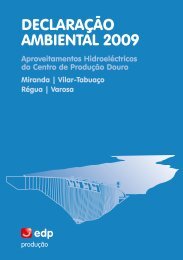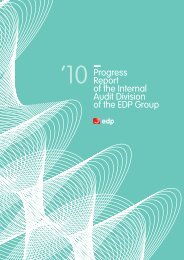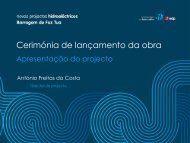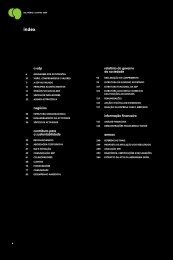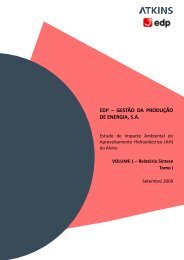Annual Report - EDP
Annual Report - EDP
Annual Report - EDP
- No tags were found...
Create successful ePaper yourself
Turn your PDF publications into a flip-book with our unique Google optimized e-Paper software.
notes to the <strong>EDP</strong> consolidated - Energias de Portugal, and company S.A. financial statementsNotes to for the the Consolidated years and ended Company 31 december Financial Statements 2012 and 2011for the years ended 31 December 2012 and 2011Costs incurred by the Group directly related to the development of software, that are expected to generate economic benefits beyond one year, are recognised asintangible assets. Such costs include employee costs directly associated to the project and are amortised on a straight-line basis over the estimated useful life of thesoftware.Software maintenance costs are charged to the income statement when incurred.Concession rights on distribution of electricity and gasThe concession rights on distribution of electricity in Brazil and the concession rights related to the distribution of gas in Portugal, are recorded as intangible assets anddepreciated on a straight-line basis over the concessions period, not exceeding 30 and 40 years, respectively.Concession rights to use the public hydric domainPortuguese concession rights to use the public hydric domain are booked as intangible assets and depreciated on a straight-line basis over the concession period,which currently does not exceed 45 years. <strong>EDP</strong> Group records as concession rights the financial compensations for the use of public domain assets, whenever thesecompensations are paid and for all the Group subsidiaries.The accounting policy related to intangible assets attributed to concessions is described in note 2aa), Group concession activities.Industrial property and other rightsIndustrial property and other rights are depreciated on a straight-line basis over the estimated useful life of the assets, which does not exceed 6 years.j) LeasesThe Group classifies its lease transactions as finance leases or operating leases based on the substance of the transaction rather than its legal form. A lease isclassified as a finance lease if it transfers to the lessee substantially all the risks and rewards incidental to ownership. All other leases are classified as operatingleases.Operating leasesLease payments under operating lease contracts are recognised as an expense in the period to which they relate.Finance leasesFinance leases are recognised by the lessee, at the inception of the lease, as assets and liabilities at the fair value of the leased assets which is equivalent to thepresent value of the future lease payments.Lease payments include the interest charges and the amortisation of the outstanding principal. The interest charges are recognised as costs over the lease period inorder to produce a constant periodic rate of interest on the remaining balance of the liability.Lessors record assets held under finance leases as leased capital, by the net amount invested in the lease.Lease payments include the financial income and the amortisation of the outstanding principal.Financial results recognised reflect a constant periodic rate of return on the outstanding net balance of the lessor.Determining whether an Arrangement contains a LeaseFollowing the issuance by International Financial <strong>Report</strong>ing Interpretations Committee (IFRIC) of IFRIC 4 - Determining whether an arrangement contains a lease,applicable from 1 January 2006, arrangements including transactions that, although do not take the form of a lease, convey the right to use an asset in return for apayment, are recognised as leases, provided that, in substance, they comply with the requirements defined in the interpretation.k) Investment propertyThe Group classifies as investment property, property held for capital appreciation and/or for rental purposes.Investment property is recognised initially at acquisition or production cost, including directly attributable transaction costs, and is subsequently measured at cost lessaccumulated depreciation and any impairment losses.Subsequent expenditures on investment property are only added to the cost of the asset when it is probable that additional future economic benefits will arise whencompared to initial recognition.l) InventoriesInventories are measured at the lower of acquisition cost and net realisable value. The cost of inventories includes purchases, conversion and other costs incurred inbringing the inventories to their present location and condition. The net realisable value is the estimated selling price in the ordinary course of business less theestimated selling costs.The cost of inventories is determined by using the weighted average method.CO 2 licenses held by the Group for trade purposes are booked as inventories and measured at fair value, at each balance sheet date, against the income statement.<strong>EDP</strong> - <strong>Annual</strong> <strong>Report</strong> 2012183







